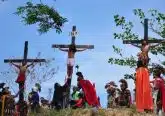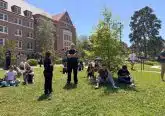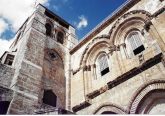Looking for hope and the next generation of Latino leaders at Encuentro
By Rhina Guidos
WASHINGTON (CNS) — The sunny weather was calling many of Washington’s 20-somethings to rooftop pools, outdoor bars and bicycle rides, just as nectar calls birds to flowers, but Francisco Hernandez, 26, and Flor Diaz, 24, decided to spend the summer afternoon and early evening of June 24 in the church basement at the Shrine of the Sacred Heart in Washington.
Sometimes the two danced or talked in front of a crowd of about 50, trying to keep the conversation going during their parish meeting marking the first stages of the Encuentro, a four-year-long process of meetings and gatherings aimed at figuring out the needs of Latino Catholics in the U.S.
Around the country, parishioners in many Catholic churches with healthy Latino populations, such as the Shrine of the Sacred Heart, are hosting similar events, which they hope will yield not just information about the up-and-coming group in the church, but also Latino leaders, missionary action and a zeal for Catholic identity in the fastest-rising ethnic population in the church.
Such meetings with Latino Catholics have taken place in the U.S. Catholic Church before and they began as far back as 1972 as a way for the country’s bishops to figure out how to better serve Latinos. However, this one seems to be particularly focused on young Latinos such as Diaz and Hernandez.
“We have to tell (the bishops), ‘This is what we need’ … but we also have to say, ‘This is how we’re going to help,'” said Carola Cerezo-Allen to those gathered, as she was leading the late June gathering. “We have to make concrete commitments.”
Capuchin Franciscan Father Moises Villalta, the church’s pastor, said he sees hope in the process but also would love to see more involvement.
“It’s yielded new leaders and that’s good,” he said. “They’ve taken the first step … but I also think about those who haven’t responded to the call.”
If all goes well with the Encuentro process, which organizers call the “V Encuentro” because it’s the fifth time it’s taking place, church officials hope it will yield an increase in vocations of Latinos to the priesthood, religious life, permanent diaconate, an increase in the percentage of Latino students enrolling at Catholic schools, and create a group of Latino leaders for the church, as well as increase Latinos’ sense of belonging and stewardship in the U.S. church where their numbers are rising.
A 2016 report by the Center for Applied Research in the Apostolate at Georgetown University commissioned by the U.S. bishops showed that more than half of millennial-generation Catholics born in 1982 or later are Hispanic or Latino. Though there is great promise in the number, at the fall 2016 meeting of U.S. bishops in Baltimore, Boston Cardinal Sean P. O’Malley expressed concern that the younger generations of Latino Catholics “is a demographic that is slipping away from the church and I think we have a window of opportunity and the window of opportunity is closing.”
Many are joining the rank of the “nones,” said Cardinal O’Malley, referring to the growing number of Americans who are choosing to be unaffiliated with any organized religion, and he urged action to retain them.
Pastors on the frontlines, such as Father Villalta, agree and also see a particular urgency in reaching the group. There’s always discussion about secularism and the lure of materialism, and certainly those are issues, Father Villalta said, but he also sees an attack on minority youths from authorities and that, in turn, makes them feel less welcome.
“There’s a great distrust of them,” said Father Villalta about the minority youth. “People paint them as invaders, gang members … and that’s not true, there are a lot of good stories. … Today, here at Sacred Heart, we had a lot of (young Catholic Latinos) come in their caps and gowns. They graduated from (The Catholic University of America), other universities, high school. They go to school, work two jobs, help their families. … Those stories are not told. People shouldn’t say they’re out there doing bad things.”
During the Encuentro sessions, Father Villalta has found time during an otherwise busy schedule to reflect on the stories of young Latino Catholics. He hears about their struggles, including separation from their families, immigration woes, domestic violence and family abuse, he said. It helps him figure out way to better tend to them pastorally, but also to reach out to those who aren’t in the pews.
In them, he sees part of his past as a participant in the third Encuentro in Washington in the mid-1980s, which he attended as a young man in his 20s. Back then, he had ended up in Washington, fleeing from the war in his native El Salvador.
“I’m a product of the third Encuentro, that’s why I’m happy to see the young people here today,” he said, recalling that the views of youth weren’t necessarily listened to as much then as today. But what was clear back then was the bishops’ interest in extending a welcome and seeing what they could do to help Latinos, particularly immigrants like him, in an environment that somewhat resembles a bit of the backlash Latinos are experiencing today, but one in which church leaders expressed welcome. That provided great comfort, he remembers.
With the Encuentro back then, the bishops wanted Latino Catholics to know “that they were thinking about the community, that they saw the community as a blessing for this church. … It was an openness to Latino ministry,” said Father Villalta.
“And now it’s our turn to support this new group of youth, to support them as they face challenges and attacks,” he said. “We’ve made great strides, but we have to see what we can do so that they become Catholics full of joy, happy to be active participants in the church.”
Flor Diaz, who was attending the meeting, said the process had helped her find motivation, particularly to help others, especially because she’s experienced what it’s like to be helped by the church.
Even though the church had been important to her as a child, as an adolescent, she had grown distant from religion, she said, until two religious sisters came to pay a visit when she found herself at an immigration detention center in Florida.
“They came to tell me of the love of God, that I was not alone,” she told Catholic News Service.
When she left the detention center, she became determined to return to the church but also to help others as she’d been helped. The Encuentro process has provided a way to do that, she said, because it encourages missionary action as a way to deepen her faith. She said she wants to help other Latino youths who are no longer active in the church and might be facing struggles.
“It’s given me a way to be part of something,” she said.
Francisco Hernandez, too, said he was eager to help, particularly after hearing of the struggles others like him face, and said he wanted them to feel the “joy of returning” to the church, the relief and happiness found in the word of God, he said.
Father Villalta said the process has helped the parish community reflect about what’s needed to tend to help younger generations of Latino Catholics — inside and outside the parish.
“We need a new evangelization,” he said. “And there’s an urgency. That evangelization will only be possible if we decide to get into the game, to stop being spectators. We have to participate and take that first step.”
– – –
Follow Guidos on Twitter: @CNS_Rhina.
– – –
Copyright © 2017 Catholic News Service/U.S. Conference of Catholic Bishops. www.catholicnews.com. All rights reserved. Republishing or redistributing of CNS content, including by framing or similar means without prior permission, is prohibited. You may link to stories on our public site. This copy is for your personal, non-commercial use only. To request permission for republishing or redistributing of CNS content, please contact permissions at [email protected].













